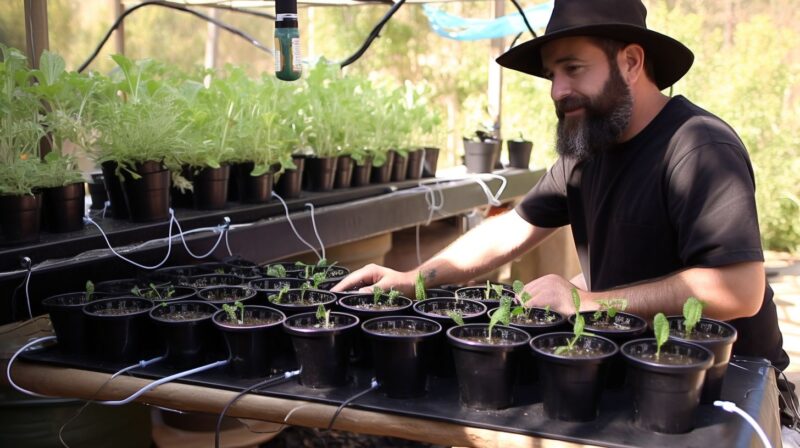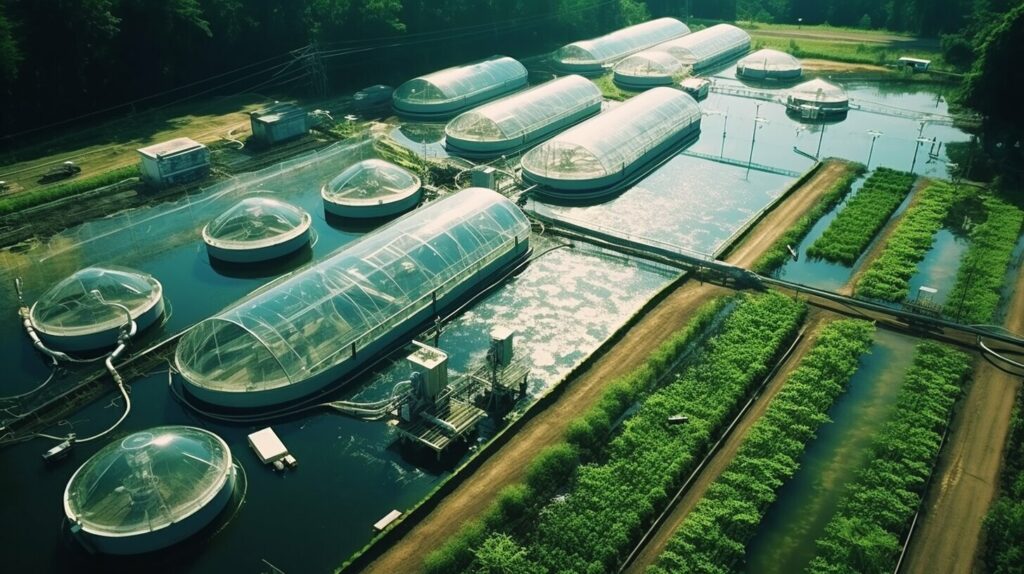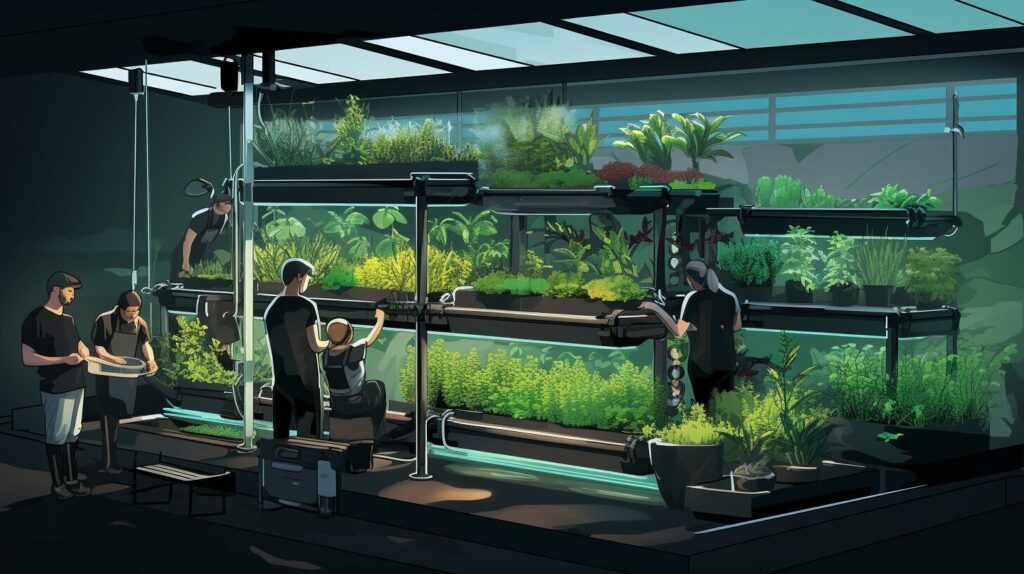This post may contain affiliate links and we may earn a small commission when you click on the links at no additional cost to you. As an Amazon Affiliate, we earn from qualifying purchases. You can read our full disclaimer here.
Welcome to the world of aquaponics, where fish and plants coexist in a symbiotic relationship to create a thriving ecosystem. Maintaining a healthy aquaponics system requires considering various factors, including water quality, nutrient balance, and aeration. This section will focus on aeration techniques and their contribution to your system’s efficiency, fish health, and yield.
Key Takeaways:
- Aeration is crucial for maintaining a healthy aquaponics system and increasing efficiency.
- Proper aeration techniques contribute to fish health and higher yield.
- Various aeration equipment and techniques, such as air pumps, stones, and water pumps, are available.
- Oxygenating fish tanks and grow beds are important techniques for promoting healthy fish and plant growth.
- Maintaining proper aeration in aquaponics systems requires consistent monitoring and preventative maintenance to avoid equipment clogs and low oxygen levels.
The Role of Aeration in Aquaponics Systems
If you’re interested in aquaponics, you know that aeration is critical for maintaining the health of your fish and plants. Without adequate aeration, your system can quickly encounter problems with low dissolved oxygen levels, leading to stressed fish and poor plant growth.
In an aquaponics system, aeration is necessary to keep the water oxygenated, which is essential for the health of fish and plants. Your fish tank needs to be properly aerated to keep your fish healthy, and your grow beds require adequate aeration to provide oxygen to the roots of your plants.
Aeration’s most important function is maintaining high dissolved oxygen levels in the water. High dissolved oxygen levels are critical to fish survival and help keep the water quality in check. In addition, proper aeration helps to prevent ammonia buildup and other issues that can occur in an aquatic environment without adequate oxygen.
| Aeration Techniques | Fish Tank | Grow Beds |
|---|---|---|
| Air pumps | Air stones | Air pumps |
| Water pumps | Filtration systems | Water flow adjustments |
A variety of aeration techniques can be used in an aquaponics system. Some common techniques used for fish tanks include air pumps and air stones, while water pumps may be more suitable for grow beds. All these techniques help circulate the water, ensuring adequate oxygen is available for the fish and plants in your system.
It’s important to regularly test the dissolved oxygen levels in your aquaponics system to ensure that the water quality is optimal for your fish and plants. If the levels are too low, adjusting your aeration techniques or increasing the aeration in your system may be necessary.
In summary, aeration plays a crucial role in the health and productivity of aquaponics systems. By maintaining optimal dissolved oxygen levels, you can promote the growth of healthy fish and plants while also preventing issues like ammonia buildup and low water quality. Your aquaponics system can thrive with the right aeration techniques and regular maintenance.
Aeration Techniques for Aquaponics Systems: Types of Aeration Equipment
Several types of aeration equipment are available for aerating your aquaponics system. The most common types are air pumps, stones, and water pumps.
An air pump is a small, electric device that pumps air into the water. You can attach air stones to the end of the tubing to disperse the air bubbles throughout the water. These bubbles help to oxygenate the water, which is essential for the health of your fish and plants.
Air stones come in various shapes and sizes. Some models produce fine, uniform bubbles, while others create larger bubbles. The size and type of air stone you choose will depend on the size of your system and the specific needs of your fish and plants.
Water pumps are another type of aeration equipment commonly used in aquaponics systems. These pumps circulate the water around the system, which helps to oxygenate it. However, it’s important to note that water pumps are less effective at oxygenating water than air pumps and stones.
When choosing aeration equipment for your aquaponics system, consider the size of your system, the specific needs of your fish and plants, and your budget. Combining air pumps and stones is often the most effective way to ensure adequate aeration throughout your system.
Aeration Techniques for Fish Tanks in Aquaponics

If you have fish in your aquaponics system, ensuring adequate oxygen levels for their health is crucial. Aeration techniques can help maintain optimal conditions in your fish tank and prevent issues like low oxygen levels and ammonia buildup. Below are some effective aeration techniques for fish tanks in aquaponics:
1. Filtration Systems
Filtration systems can help increase the oxygen levels in your fish tank by breaking down organic matter and releasing oxygen. A biofilter, for example, can convert ammonia into nitrate, which releases oxygen into the water. A mechanical filter can also help remove waste and debris from the water, improving water quality and oxygen levels.
2. Air Stones
Air stones are a popular aeration technique among aquaponics enthusiasts. They release air bubbles into the water, increasing oxygen levels and creating water movement. This movement oxygenates the water, helps distribute nutrients, and prevents stagnant spots in the tank. You can use a single air stone or multiple stones, depending on the size of your fish tank.
3. Water Flow Adjustments
Adjusting the water flow in your fish tank can also help increase oxygen levels. Increasing the water flow can create more surface agitation, increasing surface oxygen exchange. If your fish tank has a waterfall or other water feature, this can also help oxygenate the water.
By using these aeration techniques, you can ensure that your fish have the optimal oxygen levels for their health, leading to a thriving aquaponic system.
Aeration Techniques for Grow Beds in Aquaponics
If you want to maximize plant growth and ensure the health of beneficial bacteria in your aquaponics system, applying effective aeration techniques to your grow beds is essential. Here are some methods to oxygenate your plant roots and promote optimal nutrient availability:
- Use air stones in your grow bed to distribute oxygen evenly throughout the root zone.
- Adjust water flow to ensure oxygenation reaches every corner of the bed, providing vital nutrients to all plant roots.
- Employ swirl filters or other filtration systems to remove solid waste that obstructs oxygen flow and inhibits plant nutrient uptake.
- Use a water pump to push water through the grow bed, oxygenating the root zone and maintaining a healthy environment for plant growth.
By applying these techniques, you can enhance the performance of your grow beds, improve plant growth, and bolster the health of beneficial bacteria. With proper aeration, you can create a healthy and thriving aquaponics system.
Aeration Techniques for Maintaining Aquaponic Systems
Proper aeration is essential to maintain your aquaponic system’s overall health and productivity. To ensure your aquaponic system operates at maximum efficiency, it is necessary to keep an eye on the water quality parameters, prevent clogs in aeration equipment, and maintain consistent oxygen levels.
Monitoring Water Quality Parameters
Regularly monitoring your aquaponic system’s water quality parameters, including pH, ammonia, and nitrate levels, is critical to keep your system evolving efficiently. Ensure that pH levels don’t exceed the optimal range of 6.8-7.2 and limit Ammonia levels to a maximum of 1 mg/l.
Preventing Clogs in Aeration Equipment
To prevent clogs in aeration equipment, you must ensure that the equipment is regularly cleaned and maintained. This includes checking air filters, removing any dirt or debris that may have accumulated in the pipes or air stones, and checking connections to prevent air leaks that may compromise oxygen levels in the fish tank or grow bed.
Ensuring Consistent Oxygen Levels
To maintain consistent oxygen levels in your aquaponic system, it is recommended to use air pumps, air stones, or water pumps. The equipment you choose will depend on your aquaponic system’s size and scale. Aim to achieve a dissolved oxygen level of at least 5 mg/L in both the fish tank and grow bed areas to promote optimal plant and fish health.
Aeration Techniques for Large-Scale Aquaponics Systems
When it comes to large-scale aquaponics systems, maintaining adequate aeration is crucial for the health and productivity of both fish and plants. Poor oxygenation can lead to low yields and stressed fish, among other issues. Here are some aeration techniques to optimize water flow and oxygen levels in your large-scale aquaponics system:
1. Employ a Combination of Aeration Devices
Using a combination of aeration devices is a common practice in large-scale aquaponics systems. This approach involves utilizing air pumps, stones, and water pumps to ensure adequate aeration throughout the system. Air pumps and stones are useful for oxygenating the fish tank, while water pumps can increase water flow rates in grow beds and other areas with stagnant water.
2. Enhance Water Flow
Maintaining a consistent water flow in large-scale aquaponics systems is essential for maintaining oxygen levels. One way to enhance water flow is to install or adjust existing pumps to increase the flow rate. Proper water flow also helps to prevent the buildup of uneaten fish feed and waste.
3. Monitor Oxygen Levels and Water Quality
To ensure optimal aeration in large-scale aquaponics systems, it is important to monitor oxygen levels and water quality parameters regularly. You can use oxygen sensors to measure dissolved oxygen levels in the water and adjust aeration devices accordingly. Additionally, monitoring water quality parameters such as pH, temperature, and ammonia levels can help identify potential issues and take corrective actions.
4. Prevent Clogs in Aeration Equipment
Aeration equipment such as air pumps, stones, and diffusers can clog large-scale aquaponics systems due to algae and debris buildup. Regularly cleaning these aeration devices can prevent clogging and maintain optimal oxygen levels. You can also use air filters to help prevent debris from entering air pumps.
5. Consider Oxygen Injection Systems
Oxygen injection systems can be used in large-scale aquaponics systems to inject pure oxygen into the water to achieve higher dissolved oxygen levels. These systems are typically more expensive than traditional aeration devices. Still, they may be necessary in systems with high fish stocking densities or warm water environments with lower oxygen levels.
By implementing these aeration techniques, you can optimize water flow and oxygen levels in your large-scale aquaponics system and ensure the health and productivity of your fish and plants.
Aeration Techniques for Different Water Temperatures in Aquaponics

Water temperature is a crucial factor affecting the oxygen levels in aquaponics systems. As the water temperature changes, the amount of dissolved oxygen in the water can increase or decrease, impacting the health of fish and plants. Understanding the aeration techniques suited for different water temperatures in your aquaponics system is important to ensure optimal oxygen levels, fish and plant health, and nutrient cycling.
Aeration Techniques for Cold Water Aquaponics Systems
In colder water environments, the oxygen-carrying capacity of the water decreases, making it harder for fish to breathe. Therefore, adequate aeration is crucial to maintaining healthy fish and plant growth in these systems.
Air pumps and stones are highly recommended in cold water aquaponics systems. These devices ensure a steady oxygen supply to support fish and plant life. By increasing dissolved oxygen levels, these aeration techniques help prevent issues like low oxygen levels, which can harm fish health and stunt plant growth.
Aeration Techniques for Warm Water Aquaponics Systems
In warmer water environments, the demand for oxygen increases, making it crucial to maintain optimal levels of dissolved oxygen for fish and plant health. High water temperatures can also increase the risk of ammonia buildup, which can be toxic to fish.
Water pumps and water flow adjustments are recommended in warm water aquaponics systems. These aeration techniques are useful in increasing water movement and ensuring adequate system oxygenation. Proper filtration is also essential to maintain optimal water quality parameters and reduce the risk of ammonia buildup.
No matter the water temperature in your aquaponics system, it’s important to regularly monitor the dissolved oxygen levels and take corrective action as needed. Adequate aeration and proper water quality management are key to maintaining a healthy and thriving system.
Aeration Techniques for Increasing Fish Stock Density in Aquaponics
As you aim to increase the number of fish in your aquaponics system, it is crucial to maintain proper aeration to support their health and well-being. Increasing fish stock density can lead to decreased oxygen levels and excess waste, harming the fish and plants in the system. Here are some effective aeration techniques to support a higher fish population:
1. Increase aeration equipment
The most straightforward way to support higher fish stock density is to increase the amount of aeration equipment in your system. Adding more air stones or water pumps can help ensure optimal dissolved oxygen levels throughout the fish tank and grow beds.
2. Optimize water flow
Proper water flow is crucial for maintaining adequate oxygen levels and nutrient flow for the fish. Increasing water flow can reduce waste buildup, and support increased fish stock density. However, be careful not to create excessive turbulence that can harm the fish.
3. Improve filtration
Increase the filtration for your system to help remove waste and organic material that can reduce oxygen levels. Using mechanical, biological, and chemical filtration methods will help to ensure adequate nutrient flow for the plants and fish.
4. Monitor water quality parameters
Monitoring water quality parameters regularly becomes more important as you increase fish stock density. This includes measuring dissolved oxygen, pH, ammonia, and nitrate levels. Regular monitoring allows you to adjust the aeration and other parameters to maintain a healthy environment for your fish and plants.
5. Prevent aeration equipment clogs
Clogs in aeration equipment can reduce oxygen levels and harm your fish. Regularly cleaning air stones, air pumps, and water pumps can help prevent clogs from occurring. Additionally, use a biofilter to support beneficial bacteria that can help break down waste and reduce the risk of clogs.
As you implement these aeration techniques, remember that supporting increased fish stock density requires proper planning, monitoring, and maintenance. With proper aeration and care, you can support higher fish populations while maintaining a healthy and thriving system.
Aeration Techniques for Maximizing Plant Growth in Aquaponics
Aeration is key to achieving optimal plant growth in your aquaponics system. You can improve nutrient uptake and promote healthy growth by providing adequate oxygenation to the plant roots. Here are some effective aeration techniques to maximize plant growth:
Air Stones
Air stones are aquaponics’ most popular aeration technique for growing beds. These small, porous stones are connected to an air pump, which releases air bubbles into the water. This agitation increases oxygen levels and creates a more even distribution of nutrients throughout the media bed. By using air stones, you can help to prevent anaerobic conditions and promote healthy plant growth.
Water Flow
In addition to air stones, adjusting water flow is another effective way to improve plant aeration and nutrient delivery. Increasing water flow to the media bed can create more oxygenation and promote healthy root growth. However, avoid excessively high water flow rates, as this can damage fragile plant roots.
Filtration System
A filtration system can also help to promote healthy plant growth by improving water quality and increasing oxygenation. A well-designed filtration system can remove excess nutrients and prevent the buildup of harmful bacteria, ensuring that your plants receive the proper balance of nutrients and oxygen.
Beneficial Bacteria
Beneficial bacteria are important in improving nutrient availability and promoting healthy plant growth. These microorganisms help to break down organic matter and convert nutrients into forms that plants more easily absorb. By promoting the growth of beneficial bacteria through proper aeration and filtration, you can improve nutrient availability and support healthy plant growth.
Implementing these aeration techniques can help maximize plant growth and ensure your aquaponics system functions efficiently. By promoting healthy plant growth, you can also improve water quality and support the health of your fish. Focus on creating a well-balanced system that prioritizes adequate aeration and nutrient delivery, and you’ll be on your way to a thriving aquaponics setup.
Conclusion
Proper aeration boosts fish health, enhances plant growth, and increases yield.
Remember, various aeration techniques and equipment, such as air pumps, stones, and water pumps, are available. Each type has its benefits and purpose within the system. By implementing the appropriate aeration techniques and regularly monitoring water quality parameters, you can optimize your aquaponics system’s efficiency and maintain consistent oxygen levels.



